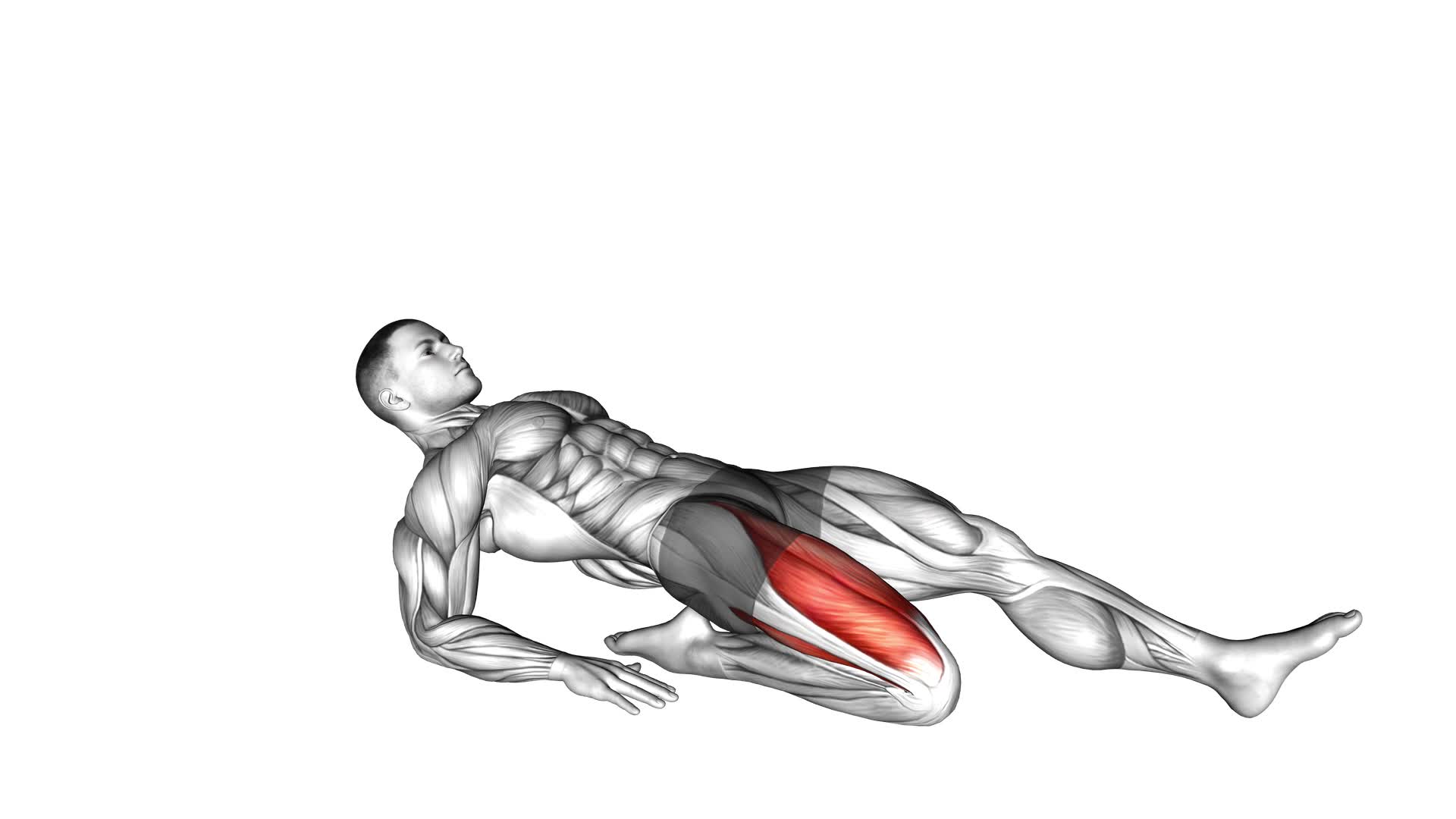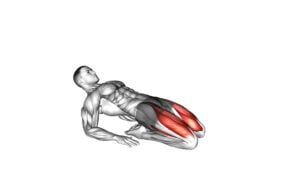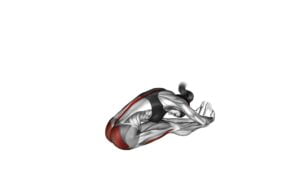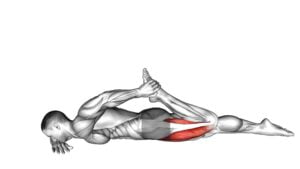Single Lean Back Quadriceps Stretch – Video Exercise Guide & Tips

Are you looking to improve your flexibility and strengthen your quads? Look no further than the Single Lean Back Quadriceps Stretch! This exercise targets your quadriceps muscles and helps increase your range of motion.
Watch This Exercise Video
In this video exercise guide, we'll show you the proper technique to perform this stretch and provide valuable tips to maximize its effectiveness.
So grab a mat and get ready to give your quads a good stretch!
Key Takeaways
- The Single Lean Back Quadriceps Stretch improves quadriceps flexibility and increases range of motion in the quadriceps muscles.
- It targets and stretches the quadriceps muscles, making it beneficial for activities that require leg movements and helping to prevent muscle imbalances.
- The stretch also helps improve posture and alignment, relieves tension and tightness in the quadriceps, and enhances overall lower body mobility and function.
- To enhance the effectiveness of the stretch, resistance can be added by gently pulling the ankle, and the stretch should be held for at least 30 seconds.
Benefits of the Single Lean Back Quadriceps Stretch
To fully understand the benefits of the Single Lean Back Quadriceps Stretch, it's important for you to recognize that this exercise can greatly improve your quadriceps flexibility and overall lower body mobility. By incorporating this stretch into your fitness routine, you can effectively target and stretch the quadriceps muscles located at the front of your thighs.
One of the key benefits of the Single Lean Back Quadriceps Stretch is its ability to improve flexibility. As you lean back and lift your foot towards your glutes, you actively stretch the quadriceps, increasing their range of motion. This can be particularly beneficial for individuals who engage in activities that require a wide range of leg movements, such as running or dancing.
In addition to improving flexibility, this stretch can also help prevent muscle imbalances. Many people tend to have tight quadriceps muscles due to prolonged sitting or activities that primarily engage these muscles. By regularly performing the Single Lean Back Quadriceps Stretch, you can counteract these imbalances and promote better muscle symmetry.
Equipment Needed for the Exercise
To perform the Single Lean Back Quadriceps Stretch, you'll need minimal equipment. This exercise only requires a mat or a comfortable surface to lie down on. The mat will provide cushioning and support for your back and knees during the stretch.
If you're a beginner or have difficulty with balance, you may also want to have a chair or wall nearby for support. This will help you maintain stability while performing the stretch.
Modifications for beginners can be made by bending the non-stretching leg and placing the foot flat on the ground. This will provide additional support and make the stretch more accessible.
It is important to note that while equipment is minimal for this exercise, proper form and technique are crucial. Make sure to listen to your body and adjust the stretch as needed. If you experience any pain or discomfort, stop the exercise immediately and consult a healthcare professional.
Step-by-Step Guide to Perform the Stretch
Start by lying on your back on a mat or comfortable surface. Bend your right knee and bring it towards your chest, grabbing the ankle with your right hand. Make sure your lower back is pressed firmly against the mat. Keep your left leg extended and relaxed on the mat.
Next, gently pull your right ankle towards your glutes, feeling a stretch in the front of your right thigh. Hold this position for 15 to 30 seconds, focusing on deep breaths to help relax the muscles.
To increase the intensity of the stretch, you can try different variations. For example, you can use a strap or towel to loop around your ankle and pull it towards your glutes. This will provide a deeper stretch in your quadriceps.
Remember to maintain proper form throughout the stretch. Keep your core engaged and your back flat against the mat. Avoid arching your lower back or lifting your hips off the mat.
After holding the stretch on one side, repeat the same steps on the opposite leg. Aim to perform 2 to 3 sets on each side, gradually increasing the duration of the stretch as your flexibility improves.
Incorporating the single lean back quadriceps stretch into your routine can help improve flexibility and prevent muscle imbalances in your lower body.
Common Mistakes to Avoid
Avoid these common mistakes when performing the single lean back quadriceps stretch to prevent injury and ensure proper form:
- Rounding your back: Keep your spine straight throughout the stretch. Avoid rounding your back, as it can strain your lower back and neck.
- Leaning too far back: While it's important to lean back to stretch your quadriceps, avoid leaning too far back. This can put excessive strain on your lower back and may cause injury. Find a comfortable range of motion that allows you to feel a stretch in your quads without compromising your form.
*Tip*: Engage your core muscles to maintain stability and control during the stretch. This will help you avoid leaning too far back and maintain proper alignment.
*Tip*: Use a wall or sturdy object as support if needed. This can help you maintain balance and prevent any excessive leaning.
Tips to Enhance the Effectiveness of the Stretch
To maximize the effectiveness of the single lean back quadriceps stretch and prevent muscle strains while improving flexibility, it's important to follow a few tips.
First, incorporate a moderate level of resistance during the stretch. This can be done by gently pulling your ankle towards your glutes, feeling a stretch in the front of your thigh. By adding resistance, you engage the quadriceps muscles more effectively, leading to a deeper stretch.
In addition to resistance, it's crucial to hold the stretch for at least 30 seconds. This allows the muscles to fully elongate and promotes better flexibility. Holding the stretch for a shorter duration may not provide sufficient time for the muscles to respond and adapt.
By incorporating resistance and holding the stretch for an adequate amount of time, you can enhance the effectiveness of the single lean back quadriceps stretch. This won't only improve your flexibility but also help prevent muscle strains.
Now that you have learned how to maximize the effectiveness of this stretch, let's move on to the next section, which will discuss variations and modifications for different fitness levels.
Variations and Modifications for Different Fitness Levels
Now let's talk about how you can modify the single lean back quadriceps stretch to suit your fitness level.
Whether you're a beginner, more advanced, or dealing with a specific injury, there are modifications you can make to ensure you get the most out of this stretch.
Beginner Modifications
Try these simple modifications to make the Single Lean Back Quadriceps Stretch easier for beginners:
- Use a support: Hold onto a chair or wall for balance while performing the stretch.
- Reduce the intensity: Start by bending your knee slightly instead of fully extending it. As you build strength and flexibility, gradually increase the range of motion.
- Alternative stretches: If the Single Lean Back Quadriceps Stretch is too challenging, try alternative stretches such as the Standing Quadriceps Stretch or the Seated Quadriceps Stretch.
- Incorporate props: Place a yoga block or cushion under your knee for added support and comfort during the stretch.
- Take it slow: Don't push yourself too hard. Listen to your body and only go as far as feels comfortable.
- Remember to breathe: Deep, slow breaths can help you relax into the stretch and release tension.
Advanced Modifications
For different fitness levels, there are various advanced modifications and variations available to enhance the Single Lean Back Quadriceps Stretch. These modifications are designed to challenge your muscles and increase the intensity of the stretch. If you're looking to take your quadriceps stretch to the next level, you can try using a resistance band or a yoga strap to deepen the stretch. Another option is to incorporate a balance element by performing the stretch on an unstable surface, such as a stability ball or a BOSU ball. Additionally, you can try incorporating dynamic movements by performing the stretch while moving your leg in different directions. These advanced modifications allow you to customize the stretch according to your fitness level and goals, helping you to progress and continue challenging your muscles.
To further customize the Single Lean Back Quadriceps Stretch, the next section will discuss injury-specific modifications.
Injury-Specific Modifications
To modify the Single Lean Back Quadriceps Stretch for specific injuries, choose variations and modifications that suit your fitness level and goals. Here are some injury-specific modifications and alternative exercises to consider for injury prevention:
- If you have knee pain or a knee injury, try the standing quadriceps stretch. Stand near a wall or use a chair for support, bend one knee, and grab the ankle or foot with your hand, pulling the heel towards your glutes.
- For individuals with lower back issues, opt for the seated quadriceps stretch. Sit on the edge of a chair, cross one leg over the other, and gently press down on the raised knee to stretch the quadriceps.
- If you have ankle or foot problems, consider the supine quadriceps stretch. Lie on your back, bend one knee, and use a towel or strap to gently pull the foot towards your glutes.
Remember to always listen to your body and consult with a healthcare professional before attempting any new exercises.
Frequently Asked Questions
How Many Repetitions of the Single Lean Back Quadriceps Stretch Should I Do?
To properly perform the single lean back quadriceps stretch, it's important to know how many repetitions you should do. Doing too few repetitions may not provide enough stretch, while doing too many could lead to muscle fatigue or injury.
It's recommended to start with 2-3 repetitions on each leg and gradually increase as your flexibility improves. Remember to maintain proper form and avoid common mistakes such as arching your back or pulling on your foot too forcefully.
Can I Perform the Single Lean Back Quadriceps Stretch if I Have Knee Pain?
If you have knee pain, it's important to modify your quadriceps stretches. The single lean back quadriceps stretch may not be suitable for you. However, there are modified versions of this stretch that can be done to alleviate knee pain.
Stretching is beneficial for managing knee pain as it helps improve flexibility, reduce muscle tension, and increase blood flow to the area.
Consult with a healthcare professional or a qualified trainer for modified stretches that are safe for you.
Are There Any Alternatives to the Single Lean Back Quadriceps Stretch for Targeting the Quadriceps?
If you're looking for alternative exercises to target your quadriceps, there are a few options you can try. Lunges and squats are both great alternatives that effectively work your quads. These exercises not only help build strength but also improve flexibility.
Stretching is important for preventing injuries and improving overall performance. So, incorporating alternative exercises into your routine can provide the same benefits as the single lean back quadriceps stretch.
How Long Should I Hold the Stretch for Maximum Benefit?
When it comes to holding stretches for maximum benefit, discussion ideas vary. The duration and intensity of the stretch play important roles in achieving the desired results.
Now, let's talk about how long you should hold the stretch. Different sources may suggest different time frames, but generally, holding the single lean back quadriceps stretch for about 30 seconds to 1 minute should be sufficient. Remember to listen to your body and adjust accordingly.
Can the Single Lean Back Quadriceps Stretch Help Improve My Flexibility for Other Exercises or Activities?
Improving flexibility is crucial for enhancing performance in various exercises and activities.
The single lean back quadriceps stretch can be beneficial in this regard. By targeting the quadriceps muscles, this stretch helps to increase their range of motion and flexibility.
This improved flexibility can translate to better performance and reduced risk of injury in exercises and activities that involve the quadriceps, such as running, jumping, and squatting.
Conclusion
In conclusion, the single lean back quadriceps stretch is a beneficial exercise for stretching and strengthening the quadriceps muscles. It requires no equipment and can be easily performed with proper technique.
By avoiding common mistakes and following helpful tips, individuals can enhance the effectiveness of the stretch. Additionally, variations and modifications can be made to accommodate different fitness levels.
Incorporating this stretch into a regular exercise routine can contribute to improved flexibility and overall lower body strength.

Author
Years ago, the spark of my life’s passion ignited in my mind the moment I stepped into the local gym for the first time. The inaugural bead of perspiration, the initial endeavor, the very first surge of endorphins, and a sense of pride that washed over me post-workout marked the beginning of my deep-seated interest in strength sports, fitness, and sports nutrition. This very curiosity blossomed rapidly into a profound fascination, propelling me to earn a Master’s degree in Physical Education from the Academy of Physical Education in Krakow, followed by a Sports Manager diploma from the Jagiellonian University. My journey of growth led me to gain more specialized qualifications, such as being a certified personal trainer with a focus on sports dietetics, a lifeguard, and an instructor for wellness and corrective gymnastics. Theoretical knowledge paired seamlessly with practical experience, reinforcing my belief that the transformation of individuals under my guidance was also a reflection of my personal growth. This belief holds true even today. Each day, I strive to push the boundaries and explore new realms. These realms gently elevate me to greater heights. The unique combination of passion for my field and the continuous quest for growth fuels my drive to break new ground.







